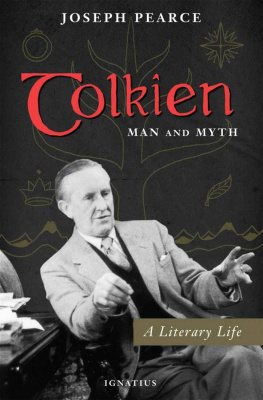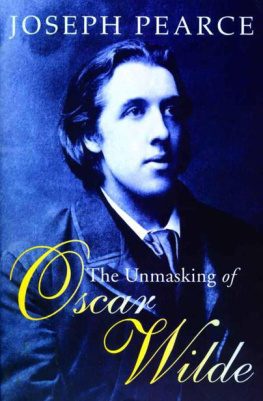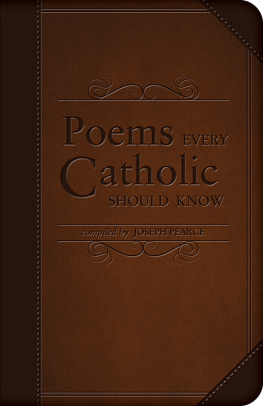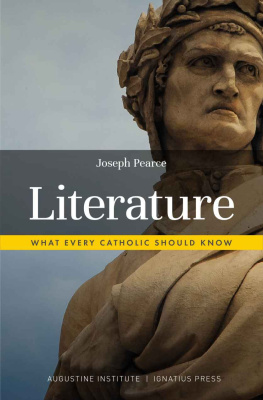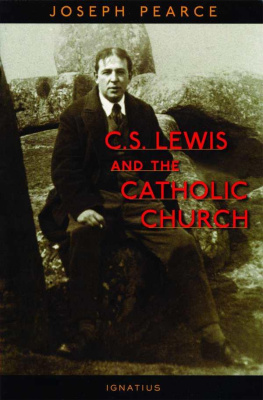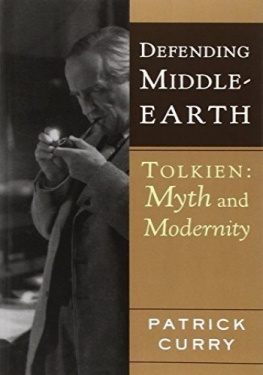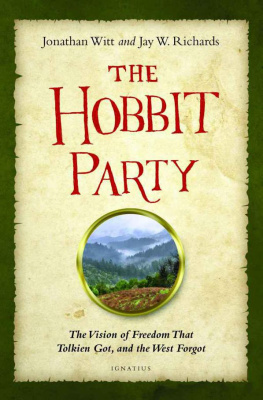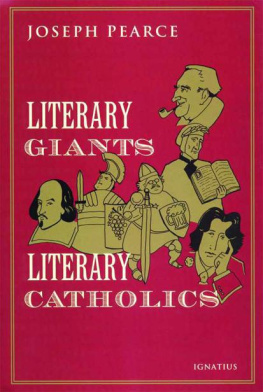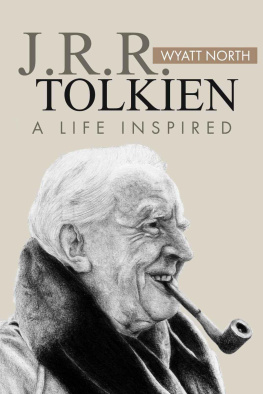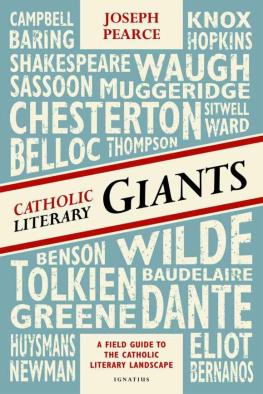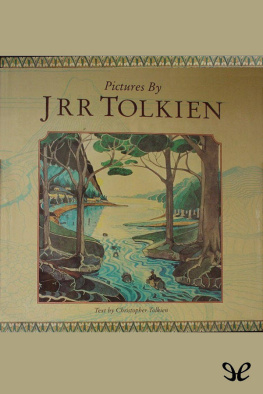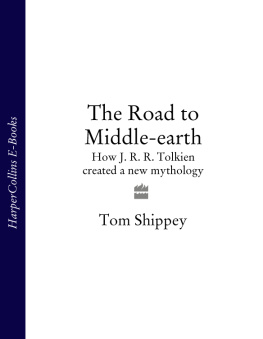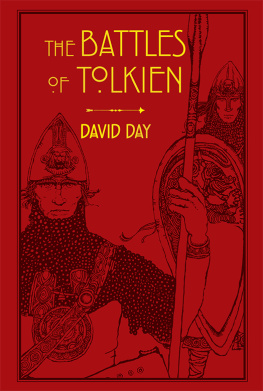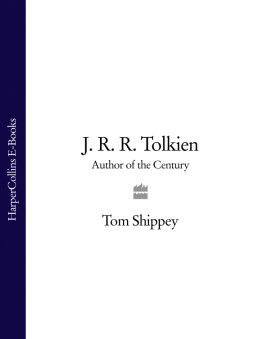TOLKIEN:
MAN AND MYTH
TOLKIEN:
MAN AND MYTH
JOSEPH PEARCE
IGNATIUS PRESS SAN FRANCISCO
First Published in Great Britain in 1998 by
HarperCollins Publishers Ltd.
1 London Bridge Street, London, SE1 9GF
Joseph Pearce asserts the moral right to be identified
as the author of this work
A catalogue record for this book is available from
the British Library
Cover photograph:
John Ronald Reuel Tolkien, December 02, 1955
Photo by Haywood Magee / Getty Images. Getty Images.
Cover design by John Herreid
Copyright 1998 Joseph Pearce
All rights reserved
Reprinted in 2019 by Ignatius Press, San Francisco
ISBN 978-0-89870-825-7 (PB)
ISBN 978-1-64229-091-2 (EB)
Library of Congress Control Number 98-073639
Printed in the United States of America
For
Owen Barfield
18981997
In Memoriam
CONTENTS
1 A Misunderstood Man:
Tolkien and the Modern World
2 Cradle Convert to the Grave:
The Child behind the Myth
3 Father Francis to Father Christmas:
The Father behind the Myth
4 True Myth:
Tolkien and the Conversion of C.S. Lewis
5 A Ring of Fellowship:
Tolkien, Lewis and the Inklings
6 The Creation of Middle Earth:
The Myth behind the Man
7 Orthodoxy in Middle Earth:
The Truth behind the Myth
8 The Well and the Shallows:
Tolkien and the Critics
9 Tolkien as Hobbit:
The Englishman behind the Myth
10 Approaching Mount Doom:
Tolkiens Final Years
Epilogue:
Above all Shadows Rides the Sun Notes
ACKNOWLEDGEMENTS
I scarcely know where to begin in the endeavour to acknowledge all the help I have received in the researching and writing of this volume. Perhaps, therefore, it is best to proceed in random fashion, mentioning the individuals concerned without any particular order of priority.
The principal published sources have been acknowledged in the Notes and are listed in the selective Bibliography at the end of the book. I am indebted to HarperCollins for permission to publish extracts from The Letters of J.R.R. Tolkien , a short extract from The Monsters and the Critics and Other Essays , the second verse of one of the poems from The Lord of the Rings , and several lines from the poem Mythopoeia. Various unpublished material was provided by Stratford Caldecott, the Director of the Centre for Faith and Culture at Westminster College, Oxford. I am also indebted to Mr Caldecott for allowing me to quote from his own essay, Tolkien, Lewis and Christian Myth, and for the hospitality he has shown me on my visits to Westminster College. While at Westminster College I also received valued assistance from Aidan Mackey, administrator of the G.K. Chesterton Library, formerly situated at the college before its recent relocation to Plater College. Staying in Oxford, I have enjoyed the help and friendship of Walter Hooper, the worlds leading authority on C.S. Lewis, and have been helped by other members of the Oxford C.S. Lewis Society, not least of whom was Richard Jeffery who was kind enough to share his considerable knowledge of both Lewis and Tolkien with me. George Sayer, Lewiss friend and biographer, has been of invaluable assistance, especially in recounting his memories of discussions with Tolkien in the 1960s. Dr Patrick Curry, author of Defending Middle Earth , has offered both advice and encouragement, as has Charles Noad, the Bibliographer of the Tolkien Society. Of the clergy who have helped, Father Charles Dilke of the London Oratory and Father Ricardo Irigaray of Buenos Aires, author of The Theological Style of J.R.R. Tolkien , deserve special mention, as does Father Robert Murray SJ. I am grateful to Paul Ellis, Elwyn Fairburn, Helene Felter, Michael Ward and Alan Young for help in various ways; to A.F.W. Simmonds who has helped in ways too numerous to mention; and to Sarah Hollingsworth, as ever, for her critical appraisal of the original manuscript. Neither must I omit to mention the crucial part played by James Catford whose enduring faith in my work has helped to bring my efforts to fruition.
Finally, I must acknowledge a debt to Owen Barfield, a key member of the Inklings and a friend of both Lewis and Tolkien, who agreed to meet me even though he was in deteriorating health. Sadly, he died shortly before this volume was completed. I dedicate what follows to his memory and as a tribute to his literary achievement.
PREFACE
W hen Tolkiens The Lord of the Rings was voted the greatest book of the century in a nationwide poll at the beginning of 1997 the critical response was not one of approbation but of opprobrium. Tolkien, it seemed, was as controversial and as misunderstood as ever, prompting the same popular acclaim and critical hostility that had greeted the books initial publication more than forty years earlier.
It was in the wake of the controversy caused by Tolkiens triumph in the Waterstones poll that the idea for this volume was conceived. Tolkien: Man and Myth is an effort to get to grips with the man, the myth and the whole phenomenon that has delighted millions of readers and perplexed and apoplexed generations of critics. It is an attempt to unravel the mystery surrounding this most misunderstood of men. In order to do so, a biographical approach has been adopted that endeavours to adhere to the scale of significance which Tolkien himself ascribed to the facts of his life in a letter written shortly after The Lord of the Rings was published. In this letter Tolkien expressed his distrust of much modern biography:
I object to the contemporary trend in criticism, with its excessive interest in the details of the lives of authors and artists. They only distract attention from an authors work... and end, as one now often sees, in becoming the main interest. But only ones guardian Angel, or indeed God Himself, could unravel the real relationship between personal facts and an authors works. Not the author himself (though he knows more than any investigator), and certainly not so-called psychologists.
But, of course, there is a scale of significance in facts of this sort.
Tolkien then divides the facts of his own life into three distinct categories, namely the insignificant, the more significant and the really significant:
There are insignificant facts (those particularly dear to analysts and writers about writers): such as drunkenness, wife-beating, and suchlike disorders. I do not happen to be guilty of these particular sins. But if I were, I should not suppose that artistic work proceeded from the weaknesses that produced them, but from other and still uncorrupted regions of my being. Modern researchers inform me that Beethoven cheated his publishers, and abominably ill-treated his nephew; but I do not believe that has anything to do with his music.
Apart from these insignificant facts, Tolkien believed that there were more significant facts, which have some relation to an authors works. In this category he placed his academic vocation as a philologist at Oxford University. This had affected his taste in languages which was obviously a large ingredient in The Lord of the Rings . Yet even this was subservient to more important factors:
And there are a few basic facts, which however drily expressed, are really significant. For instance I was born in 1892 and lived for my early years in the Shire in a pre-mechanical age. Or more important, I am a Christian (which can be deduced from my stories), and in fact a Roman Catholic.
Accepting Tolkiens premise that the author knows more than any investigator about the important events in his life, his own scale of significance has been employed as the starting point in the effort to unmask the man and unravel the myth. Consequently, those facts which Tolkien considered most significant to his life and work have formed the basis of this book. His academic career and his taste in languages have not been discussed at length, partly because the author is not qualified to do so and partly because this aspect of his life and creativity has been covered extensively in learned studies by T.A. Shippey and Verlyn Flieger. Instead, the crucial importance of Tolkiens Christianity and the enduring importance of his early years in the pre-mechanical Shire are given priority.
Next page
